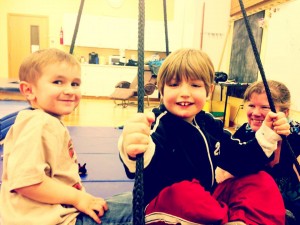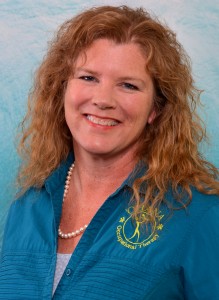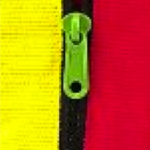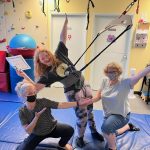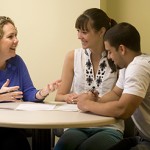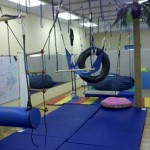Obstacle courses allow us to efficiently address multiple OT goals with one fun activity!
Cognitive/ Thinking Skills
• Sequencing and planning
• Following directions
• Memory
• Ability to think of new ideas/ Flexibility / Creativity
• Problem Solving
Communication
• Cooperation
• Taking Turns
• Waiting calmly
• Collaboration with others to solve problems
• Self esteem, sense of accomplishment
• Play skills , having Fun!
Fine Motor / Visual Perception
• Finger and grasp strength (e.g. opening carabineers, grabbing trapeze)
• Eye hand coordination (e.g. connecting and threading webbing into carabineers)
• Writing grasp (e.g. labeling and drawing map of obstacle course and then giving it a star rating)
• Ocular motor skills, separating eye/head movements (e.g. throwing to a target while on a swing, watching a moving swing and timing transition to it)
• Visual spatial awareness (e.g. planning the spacing of the course and drawing a map of it)
Gross Motor
• Balance • Strength (upper body, lower body and core)
• Postural control and protective reflexes
• Bilateral coordination (using both sides of the body)
• Timing of movements and speed (moving faster and slower)
Safety Awareness
• Following safety rules
• Waiting until therapist is ready
• Safely maneuvering body up/down ladders and on/off equipment
• Thinking about consequences and placement of padding
It builds a strong sensory motor foundation of Kinesthesia (physical sense of self) which is a basic need for all skilled activities (motor, social, academic, cognitive, and attention).
• Proprioception (nerve receptors in muscles and joints)– bouncing, jumping, pulling, pushing, lifting, climbing
• Vestibular (nerve receptors in inner ear)– movement in all directions up, down, around and angular
• Tactile- Varied materials in contact with the body (e.g. spandex, carpet, beans, shaving cream)
Mary Kostka is a Pediatric Occupational Therapist specializing in Sensory Processing Disorder at her private practice, ‘Ohana Occupational Therapy, LLC, in Wenatchee and Leavenworth Washington.
